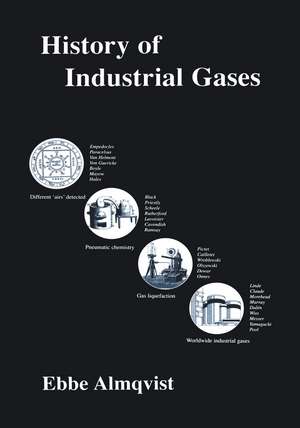History of Industrial Gases
Autor Ebbe Almqvisten Limba Engleză Paperback – 19 sep 2012
| Toate formatele și edițiile | Preț | Express |
|---|---|---|
| Paperback (1) | 959.36 lei 6-8 săpt. | |
| Springer Us – 19 sep 2012 | 959.36 lei 6-8 săpt. | |
| Hardback (1) | 968.19 lei 6-8 săpt. | |
| Springer Us – 30 ian 2003 | 968.19 lei 6-8 săpt. |
Preț: 959.36 lei
Preț vechi: 1169.95 lei
-18% Nou
Puncte Express: 1439
Preț estimativ în valută:
183.57€ • 191.66$ • 151.93£
183.57€ • 191.66$ • 151.93£
Carte tipărită la comandă
Livrare economică 05-19 aprilie
Preluare comenzi: 021 569.72.76
Specificații
ISBN-13: 9781461349624
ISBN-10: 1461349621
Pagini: 492
Ilustrații: XVIII, 472 p.
Dimensiuni: 178 x 254 x 26 mm
Greutate: 0.84 kg
Ediția:Softcover reprint of the original 1st ed. 2003
Editura: Springer Us
Colecția Springer
Locul publicării:New York, NY, United States
ISBN-10: 1461349621
Pagini: 492
Ilustrații: XVIII, 472 p.
Dimensiuni: 178 x 254 x 26 mm
Greutate: 0.84 kg
Ediția:Softcover reprint of the original 1st ed. 2003
Editura: Springer Us
Colecția Springer
Locul publicării:New York, NY, United States
Public țintă
ResearchDescriere
Starting at the dawn of science, History of Industrial Gases traces the development of gas theory from its Aristotelian roots to its modern achievements as a global industry. Dr. Almqvist explores how environmental protection, geographical areas, and the drive for higher purity and efficiency affected development in the nineteenth and twentieth centuries, and how they will influence the future of this rapidly expanding industry. The roles of major contributing companies are also discussed to provide an informative and thought-provoking treatise valuable to anyone who studies or works in this fascinating field.
Cuprins
Contents. Preface. 1. History of gases - Introduction. 2. From Aristotle to the birth of modern chemistry. 3. The industrial gases background. 4. The industrial gas technology development. 5. The industrial gas business development. 6. The industrial gas business expansion. 7. How new gas applications developed. Index.
Recenzii
"This 450-page pastiche of well-researched and well-documented vignettes, anecdotes, thumbnail sketches, and priceless illustrations and drawings is, as advertised, a marvelous excursion into the history of industrial gases. Embedded between the end papers of what might at first seem only to interest a precious few specialists are the essence of stories on hydrogen, including lighter-than-air craft and ballooning; dry ice and refrigeration; acetylene and illumination; gaslight and limelight; noble gases and the quest for absolute zero; industrial helium, superconductivity, and superfluidity; cutting and welding; rocket fuels, buzz bombs, and space travel; cryogenics, cyngas, and LPG. On and on. An impressive scientific and engineering retrospective... References are properly annotated, accurately displayed, and well represented; illustrations are appropriate and often original; the engineering drawings are more than window dressing. Empedocles and Paracelsus would be pleased... Put this in your library. It's a gas! Summing up: Essential."
(L.W. Fine, Columbia University in Choice, December 2003)
"Almqvist's book is a tour de force, which gives insight, not only into the historical development of the gas production industries, but also in new technologies, such as gas welding and cutting, rocket propulsion, biological and medical applications. In addition the author lets us meet the scientists and entrepreneurs whose worl lies behind all this. A well researched book in the best tradition of the Newcomen Society."
(Jan Hault)
(L.W. Fine, Columbia University in Choice, December 2003)
"Almqvist's book is a tour de force, which gives insight, not only into the historical development of the gas production industries, but also in new technologies, such as gas welding and cutting, rocket propulsion, biological and medical applications. In addition the author lets us meet the scientists and entrepreneurs whose worl lies behind all this. A well researched book in the best tradition of the Newcomen Society."
(Jan Hault)


